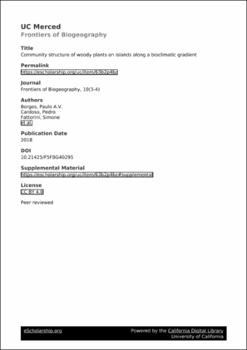Community structure of woody plants on islands along a bioclimatic gradient
Author
Borges, Paulo A. V.; Cardoso, Pedro; Fattorini, Simone; Rigal, François; Matthews, Thomas J.; Di Biase, Letizia; Amorim, Isabel R.; Florencio, Margarita; Borda de Água, Luis; Rego, Carla; Pereira, Fernando; Nunes, Rui; Carvalho, Rui; Ferreira, Maria Teresa; López, Heriberto; Pérez Delgado, Antonio J.; Otto, Rüdiger; Fernández Lugo, Silvia; Nascimento Reyes, Lea de ; Caujapé‑Castells, Juli; Casquet, Juliane; Danflous, Samuel; Fournel, Jacques; Sadeyen, Anne-Marie; Elias, Rui B.; Fernández-Palacios, José María
; Caujapé‑Castells, Juli; Casquet, Juliane; Danflous, Samuel; Fournel, Jacques; Sadeyen, Anne-Marie; Elias, Rui B.; Fernández-Palacios, José María ; Oromí, Pedro; Thébaud, Christophe; Strasberg, Dominique; Emerson, Brent C.
; Oromí, Pedro; Thébaud, Christophe; Strasberg, Dominique; Emerson, Brent C.
Date
2018Abstract
Understanding patterns of community structure and the
causes for their variation can be furthered by comparative biogeographic
analyses of island biotas. We used woody plant data at the local scale to
investigate variations in species rarity, alpha, beta, and gamma diversity
within and between three islands from the oceanic archipelagoes of
Azores, Canaries and Mascarene. We used standardized protocols to
sample ten 50 m × 50 m forest plots in each of the three islands with
contrasting climate and regional species pools: Terceira (Azores),
Tenerife (Canaries), and Reunion (Mascarene Islands). Occupancy
frequency distributions and species abundance distributions were
used to investigate rarity. The partitioning of beta diversity in a
distance-decay framework was used to test for spatial patterns of
community composition. Rarity was much more pronounced in the
highly diverse islands of Tenerife and Reunion than in the regionally
poorer island of Terceira. The number of species rose faster with
increasing sample area in both Tenerife and Reunion. The slope of
the species rank abundance curve was steeper in Terceira whereas
the richer island assemblages approached a lognormal model.
Compositional changes according to spatial distance were mostly
due to replacement of species in Terceira and Reunion. Our results
point to important differences in the community structure of Terceira,
which is the less diverse and temperate region in comparison to
Tenerife and Reunion which are highly diverse.





